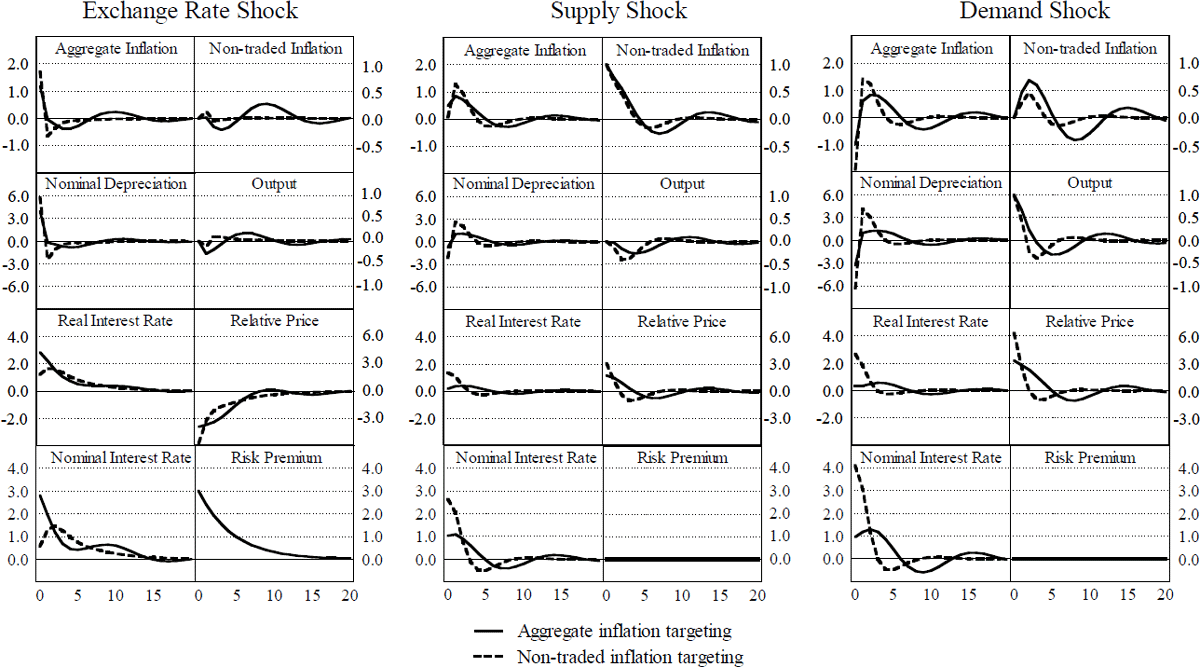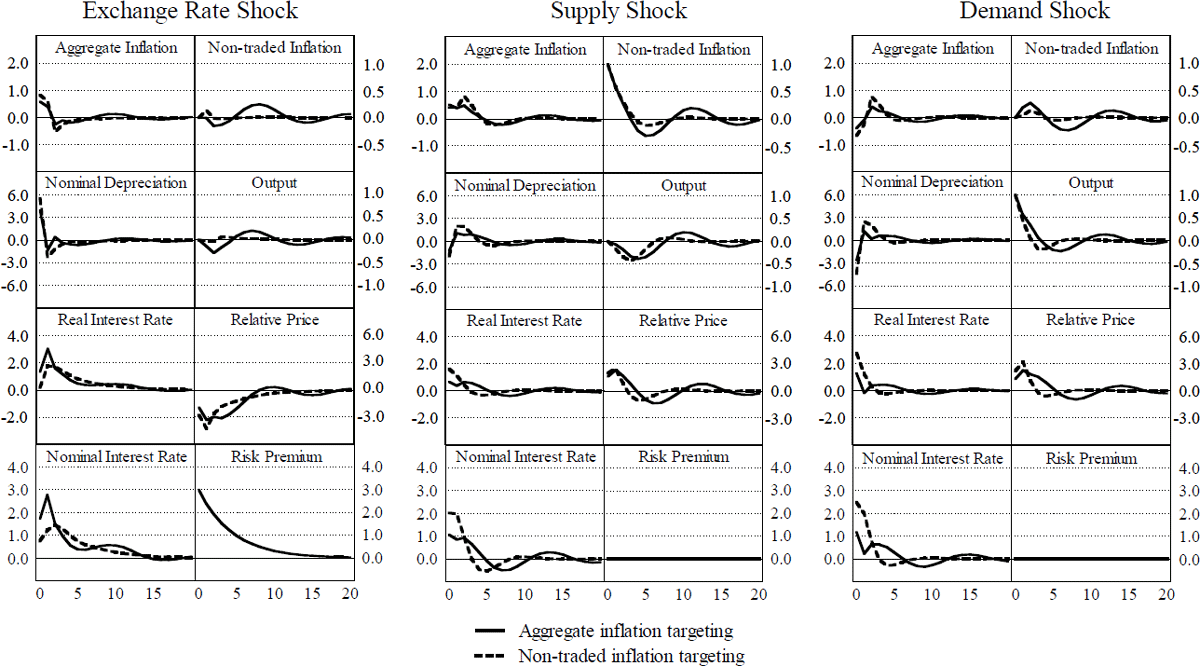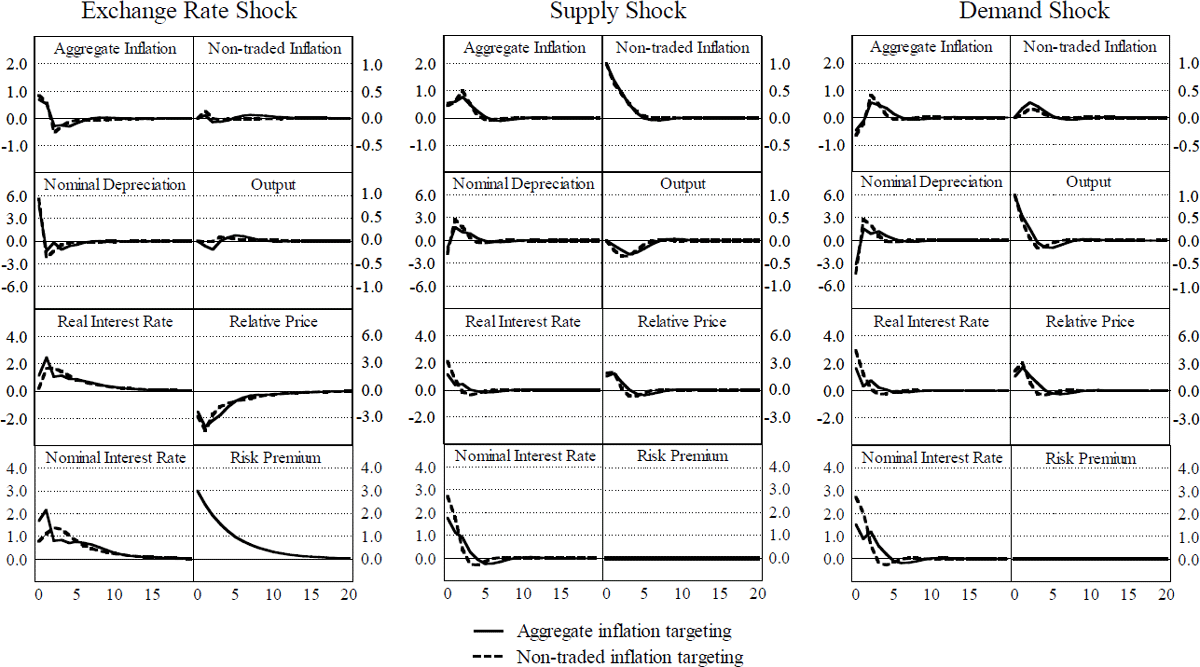RDP 9807: Inflation Targeting in a Small Open Economy Appendix C: Further Results
July 1998
- Download the Paper 422KB
| Parameter description | Parameters | Model A | Model B | Model C |
|---|---|---|---|---|
| Speed of exchange rate pass-through | α | – | – | 0.5 |
| Degree of backward-lookingness | λ | – | 0.5 | 0.5 |
| Effect of traded intermediate input on non-traded inflation |
β1 β2 |
0.025 0 |
0.025 0 |
0.025 0 |
| Effect of output gap on non-traded inflation | α | 0.2 | 0.2 | 0.2 |
| Share of traded good in consumption basket | η | 0.3 | 0.3 | 0.3 |
| Persistence of output gap | μ | 0.7 | 0.7 | 0.7 |
| Sensitivity of the output gap to the real interest rate | ø | 0.1 | 0.1 | 0.1 |
| Sensitivity of output gap to the relative price of non-traded good |
γ1 γ2 |
0 0.06 |
0 0.06 |
0 0.06 |
| Degree of persistence in risk premium | θ | 0.8 | 0.8 | 0.8 |
| Central bank's discount factor(a) | δ | 1.0 | 1.0 | 1.0 |
| Preference for targeting aggregate inflation | μπ | 1 , 0 | 1 , 0 | 1 , 0 |
| Preference for targeting non-traded inflation | μN | 0 , 1 | 0 , 1 | 0 , 1 |
| Preference for targeting output gap | μy | 0.5 | 0.5 | 0.5 |
| Preference for instrument stability | μi | 0 | 0 | 0 |
| Preference for instrument smoothing | μΔπ | 0.01 | 0.01 | 0.01 |
| Standard deviation of supply shock | σN | 1 | 1 | 1 |
| Standard deviation of demand shock | σy | 1 | 1 | 1 |
| Standard deviation of risk premium shock | σρ | 3 | 3 | 3 |
|
Notes: (a) Svensson (1998) shows that the optimisation problem is well-defined for δ = 1. |
||||
Figure C1: Model B – Impulse Response Functions

Figure C2: Model C – Impulse Response Functions

Figure C3: Model C, Discretionary Solution – Impulse Response
Functions

| π | πN | y | Δi | r | Δe | q | ||
|---|---|---|---|---|---|---|---|---|
| Shock | Aggregate inflation targeting | |||||||
| Unconditional | 2.84 | 2.14 | 1.56 | 3.59 | 4.56 | 6.45 | 9.88 | |
| Exchange rate | 1.43 | 0.63 | 0.50 | 3.08 | 4.29 | 4.26 | 7.57 | |
| Conditional | Supply | 1.45 | 1.51 | 0.53 | 1.25 | 0.84 | 2.18 | 2.93 |
| Demand | 1.99 | 1.37 | 1.38 | 1.35 | 1.29 | 4.33 | 5.64 | |
| Non-traded inflation targeting | ||||||||
| Unconditional | 3.74 | 1.49 | 1.39 | 5.84 | 5.10 | 11.18 | 10.84 | |
| Exchange rate | 1.88 | 0.13 | 0.20 | 1.05 | 3.41 | 6.35 | 7.46 | |
| Conditional | Supply | 1.69 | 1.35 | 0.63 | 3.15 | 1.83 | 4.09 | 3.64 |
| Demand | 2.75 | 0.64 | 1.23 | 4.80 | 3.32 | 8.25 | 6.97 | |
| π | πN | y | Δi | r | Δe | q | ||
|---|---|---|---|---|---|---|---|---|
| Shock | Aggregate inflation targeting | |||||||
| Unconditional | 1.47 | 1.60 | 1.62 | 3.28 | 4.63 | 5.88 | 9.18 | |
| Exchange rate | 0.84 | 0.54 | 0.55 | 2.50 | 4.11 | 4.32 | 6.90 | |
| Conditional | Supply | 0.97 | 1.37 | 0.81 | 1.34 | 1.43 | 2.42 | 4.44 |
| Demand | 0.73 | 0.61 | 1.30 | 1.64 | 1.60 | 3.16 | 4.11 | |
| Non-traded inflation targeting | ||||||||
| Unconditional | 2.03 | 1.24 | 1.33 | 4.02 | 4.97 | 8.97 | 8.47 | |
| Exchange rate | 1.18 | 0.13 | 0.12 | 1.04 | 3.33 | 6.09 | 6.45 | |
| Conditional | Supply | 1.19 | 1.22 | 0.70 | 2.53 | 2.08 | 3.63 | 3.66 |
| Demand | 1.16 | 0.17 | 1.12 | 2.94 | 3.04 | 5.49 | 4.09 | |
| π | πN | y | Δi | r | Δe | q | ||
|---|---|---|---|---|---|---|---|---|
| Shock | Aggregate inflation targeting | |||||||
| Unconditional | 1.87 | 1.40 | 1.33 | 3.54 | 4.22 | 6.82 | 7.98 | |
| Exchange rate | 1.02 | 0.16 | 0.29 | 2.24 | 3.56 | 5.03 | 6.63 | |
| Conditional | Supply | 1.25 | 1.33 | 0.51 | 2.04 | 1.34 | 2.56 | 2.67 |
| Demand | 0.94 | 0.40 | 1.19 | 1.83 | 1.84 | 3.83 | 3.55 | |
| Non-traded inflation targeting | ||||||||
| Unconditional | 2.16 | 1.33 | 1.25 | 4.71 | 5.12 | 9.10 | 8.09 | |
| Exchange rate | 1.21 | 0.14 | 0.13 | 1.01 | 3.29 | 6.19 | 6.49 | |
| Conditional | Supply | 1.34 | 1.30 | 0.58 | 3.27 | 2.31 | 3.72 | 2.87 |
| Demand | 1.18 | 0.23 | 1.10 | 3.24 | 3.17 | 5.54 | 3.88 | |
| Aggregate inflation target | Non-traded inflation target | |
|---|---|---|
| Model A – backward-looking | 11.47 | 6.58 |
| Model B – forward-looking | 9.41 | 3.55 |
| Model C – gradual pass-through | 3.60 | 2.58 |
| Model C – discretionary solution | 4.49 | 2.77 |